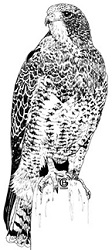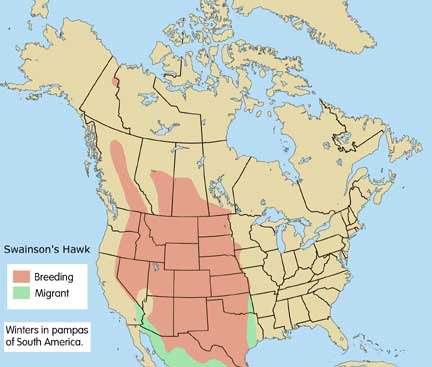
Scientific Name: Buteo swainsoni
This is a large, slender hawk of the western plains. The Swainson’s Hawk is close in size and shape to the more common Red-tailed Hawk, but has longer, narrower, more pointed wings, and a smaller bill and feet. Three subgroups have been defined by color, and the light form is the most common. These birds have a dark brown head with brown eyes, and dark brown upper parts. A wide brown band on the chest contrasts with a white throat and pale belly. The underside of the wings show white wing linings, contrasting with darkly barred flight feathers, and even darker trailing edges; the tail is gray with many narrow bands, and one wide dark band near the tip. The rufous form of this hawk has a reddish belly, and the dark form is dark overall, with a dark throat – these two subgroups account for less than 10% of the total.
Males/Females
Length: 17 – 22″
Wingspan: 47 – 54″
Weight: 1.3 – 2.7 lb.
State and federally protected. A species of concern, recent sharp population declines led to satellite telemetry projects and confirmation of huge die-offs due to use of the pesticide monocrotophos on the wintering grounds in Las Pampas, Argentina (where they are known as the ‘grasshopper hawk’ due to the huge number of grasshoppers they eat). Assistance from Canada and the US has led to the banning of the pesticide and an extensive educational effort for farmers to find effective alternatives less harmful to human and avian health.
Open country of the western US and Canada for breeding, from low to moderate elevations. Prairies, rangelands, meadows, any open areas with scattered trees — such places will be attractive to this species. Cultivated lands attract this hawk in some areas, where the human disturbance of agriculture causes concentrations of insects and rodents.
Rodents and other small mammals form the bulk of the diet during breeding season; insects are an important part of the diet at other times of the year, especially crickets and grasshoppers (in their Argentina winter grounds, they are known as the Grasshopper Hawk). These hawks also take some reptiles and amphibians, and are even attracted to swarms of bats. Depending on the type of prey, they will perch hunt, or hunt on the wing.
The Swainson’s Hawk is usually quiet outside of nesting season. The typical call is a shrill, plaintive kr-e-e-e-e-e-e-e.
Build a stick nest as high as possible on a cliff, bluff, or rock outcrop, or in a lone tree. They often return to the same nest each year, which can be up to 3 or 4 feet across.
Collision with vehicles is the most common problem here. While migrating in large, insect-seeking flocks through Central and South America, this hawk is very susceptible to mass poisonings from insecticides.

The Swainson’s Hawk makes one of the longest, most spectacular fall migration flights of any North American bird species. From its breeding range throughout the western US, Canada, and Alaska, this gregarious hawk can gather into flocks of up to several thousand birds for a mass migration of over 7,000 miles to its wintering range in South America. They make the return journey back to North America in early spring. Small populations of these hawks also winter in Florida, and the Central Valley of California.
Special Thanks for range maps:
Dan Gleason
BGleason Design & Illustration
Commercial & Scientific Illustration, Graphic Design
CraneDance Communications
Book Production/Design

